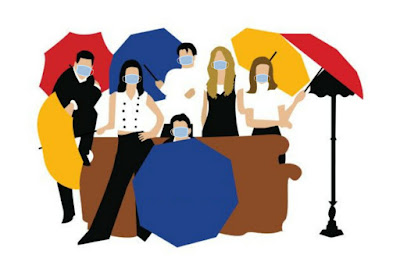Whatever You're Into, Get Into Vaccine Pandemic
A living thing that has
exhibited the characteristic of thriving on the expense of some other living
being, better than humans, as far as I can think of, might only be viruses.
Sickness has existed as long as humans have, which has brought forward the need
for medicines in human society, oldest use of prescriptions dates back to 2,112
BC – 2,004 BC in Sumer during the third dynasty of Ur.
But the way we
handle sickness now is completely different from how we went about it in the
medieval times. Yes, the credit is unanimously given to science and technology
but what really deserves the credit for our development must be the undying
human tendency to know and learn, be it John Snow, who traced the source of
cholera outbreak in London,or Edward Jenner, who found out that infection to cow
pox could create immunity to small pox, in a period when it was considered that
“demons” and other “sinful airs” were disseminating diseases.
Throughout history, humankind has benefitted from such individuals who have
from their curiosity contributed to the world we live in today.
Of course, we can praise technology for all
the comforts it has given to us on a livelong day. But what we have given it
as quid pro quo is something of exceeding importance and as
Simon Sinek puts it in his Millennial Question, one of four, pressing issues of
this generation: patience. Every comfort, knowledge and even service is as far
away as our fingertips. What this has done is that now everyone believes that
everything is achievable in an instant, largely due to the fact that the time
and effort put into making something is not visible, and it is times like these
that show us how vital patience really is. It has been more than thirty years
and still there is no cure for HIV, its first reported case goes back to 1984.
One thing that is clear is that making vaccines is cumbersome and a tedious
process.
For the uninitiated vaccine development is split into three
phases :
Exploratory phase: Wherein
scientists use different approaches of developing a testable vaccine.
Clinical trials: In this phase the vaccines are evaluated on its safety,
efficacy and side-effects across different populations. This phase is generally
the least flexible.
Manufacturing: Mass
production of vaccines to be used around the world. The process of manufacturing
vaccines goes hand in hand with the first two phases as the process of
developing each vaccine is typical and cannot be replicated. From a bit of
research and optimism it is believed that in future it would be possible to
swap the genetic material from different vaccines as per our needs but for now,
we have to suffice with what we have.
Normally this process takes up
around 15-20 years considering the time and money spent on research and
development. But desperate times require desperate measuresand scientists pull
various strings to get through each stage as quickly as possible. The exploratory
phase allows maximum flexibility. The goal of this phase is to find a way so as
to safely inject the vaccine into our system and giving our bodies the time and
information, it needs to create the antibodies which fight off the infection.
There
are many ways to invoke our immune system to respond to the vaccine
without getting overwhelmed by the surge of the foreign particles injected into
our system and there is no telling as to which one would work in our bodies.
One of the more traditional methods being attenuated vaccine which develops a
long-lasting resilience but its development consumes immense amount of time.
The other popular method of preparation of vaccine being the inactivatedvaccine
method wherein the virus is subjected to heat, acid, radioactivity and other
changes in pressure and temperature. But the catch is, being testable does not
deem a vaccine to be successful in curbing the disease, and an unsuccessful
attempt means starting from scratch. To avoid these obstacles labs from all
around the world work with coordination and unison, with each trying different
methods simultaneously so as to develop the most effective way of producing
vaccine.
This approach resulted
in the first vaccine of Zika virus in just 7 months, when it the virus ravaged
in Latin America in 2016 and the first Coronavirus vaccine in just 42 days.
The US,has moved with great speed, which is
not a surprise with the way the virus is devouring the nation. One of its
pharma giants, Pfizer and its German counterpart have begun human trials and
Modernahas begun phase-3 trials of its m-RNA-1273 vaccine. China, has also
decided not to stay behind in the race to develop a vaccine, with fiveof its
vaccines in human trials phase.
But, amongst these global super-powers how is India faring?
 We can criticize India for all the shady
politics, the education system, even the media, but trust me, we’ve never been
more thankful to hear that India is
the largest producer of vaccines in the world, manufacturing
about 60% - 70% vaccines.The Pune based Serum Institute of India has tied up with many
pharma giants all over the world such as UK’s AstraZeneca, USA’s Codagenix,
Austria’s Themisto name a few. In an
interview, the CEO of SII has claimed that they plan to bring the vaccine to
low and middle-income nations. Zydus Cadila, based in Ahmedabad has also jumped into the
race and was previously engaged in making rapid diagnostic kits. Even Bharat Biotech International Ltd. has begun clinical testing of
developing a vaccine that is indigenous to India. Apart from these, Mynvax and
Indian Immunological Ltd. are also using their grey cells for developing a
vaccine.
We can criticize India for all the shady
politics, the education system, even the media, but trust me, we’ve never been
more thankful to hear that India is
the largest producer of vaccines in the world, manufacturing
about 60% - 70% vaccines.The Pune based Serum Institute of India has tied up with many
pharma giants all over the world such as UK’s AstraZeneca, USA’s Codagenix,
Austria’s Themisto name a few. In an
interview, the CEO of SII has claimed that they plan to bring the vaccine to
low and middle-income nations. Zydus Cadila, based in Ahmedabad has also jumped into the
race and was previously engaged in making rapid diagnostic kits. Even Bharat Biotech International Ltd. has begun clinical testing of
developing a vaccine that is indigenous to India. Apart from these, Mynvax and
Indian Immunological Ltd. are also using their grey cells for developing a
vaccine.






Amazing!!
ReplyDelete